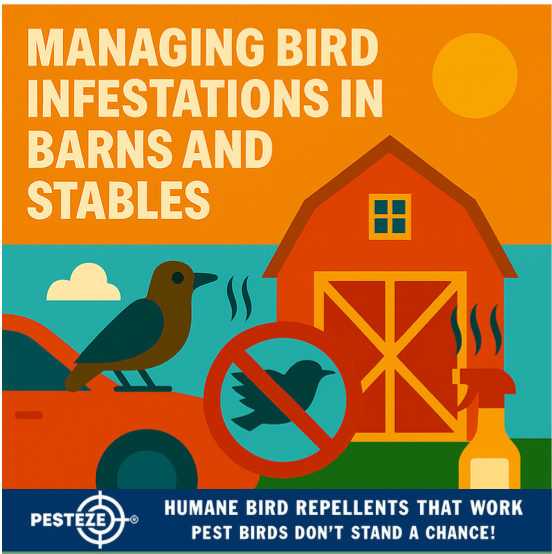MANAGING BIRD INFESTATIONS IN BARNS AND STABLES

MANAGING BIRD INFESTATIONS IN BARNS AND STABLES
SUMMARY
Bird infestations in agricultural structures pose significant health risks, property damage, and livestock welfare challenges. This comprehensive guide provides strategic solutions for effectively managing avian populations in barns and stables in 2025.
FEATURES
- Livestock Protection: Comprehensive strategies to safeguard animal health from bird-related contamination and disease risks.
- Structural Integrity: Advanced methods to prevent structural damage caused by bird nesting and droppings.
- Disease Prevention: Systematic approaches to mitigate potential pathogen transmission in agricultural environments.
- Economic Preservation: Cost-effective solutions that minimize agricultural productivity losses.
- Sustainable Management: Humane and environmentally responsible bird control techniques.
GUIDE DESCRIPTION
Bird infestations in agricultural structures represent a complex challenge that extends far beyond simple pest control. Barns and stables provide ideal environments for birds, offering shelter, warmth, and abundant food sources. These conditions create significant risks for livestock, property, and overall agricultural productivity.
The primary concerns of bird infestations include extensive contamination, potential disease transmission, and structural damage. Bird droppings can carry numerous pathogens that pose serious health risks to livestock, including respiratory diseases, fungal infections, and bacterial contaminations. The acidic nature of bird droppings can also cause rapid deterioration of building materials, compromising structural integrity.
Modern agricultural management requires a holistic approach to bird control. Traditional methods of bird deterrence often prove ineffective in large, open agricultural structures. Innovative solutions must combine multiple strategies, leveraging technological advancements and scientific understanding of bird behavior.
Technological innovations in 2025 offer sophisticated bird management solutions specifically designed for agricultural environments. Advanced sensor networks, targeted deterrent systems, and smart environmental modification techniques provide comprehensive protection for barns and stables.
Architectural and environmental modifications play a crucial role in bird infestation prevention. Sealing entry points, modifying building designs, and creating less attractive environments for birds can significantly reduce infestation risks. This approach requires a detailed understanding of local bird species, their behaviors, and specific agricultural infrastructure.
Legal and ethical considerations remain paramount in bird management strategies. Many bird species are protected by federal and local regulations, necessitating careful, humane approaches to population control. Collaboration with wildlife experts, veterinarians, and agricultural specialists becomes essential in developing effective management plans.
A comprehensive bird management strategy integrates prevention, technology, and ongoing maintenance. Regular inspections, proactive deterrence, and adaptive management techniques are crucial for long-term success in controlling bird populations in agricultural environments.
- Pukhraj Sharma


Comments 0